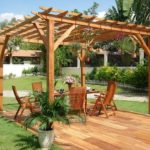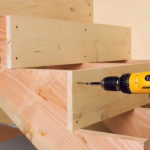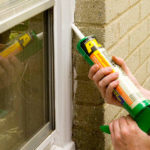How to install roll roofing on a flat or pitched roof with your own hands: installation tips and guides.
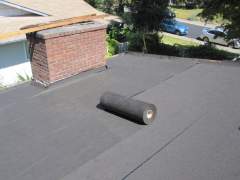 Modern technologies have significantly improve the performance of bitumen roll materials to extend their service life of up to 15-25 years and made them more universal. Modern roofing materials of this type have a solid foundation, a complex structure, high ductility and resistance to frost and can be attached to the base in different ways. Rolled roofing materials differ according to their base material, binder material and a fraction of spreading. If you are wonder how to install roll roofing, the following information may be useful for you.
Modern technologies have significantly improve the performance of bitumen roll materials to extend their service life of up to 15-25 years and made them more universal. Modern roofing materials of this type have a solid foundation, a complex structure, high ductility and resistance to frost and can be attached to the base in different ways. Rolled roofing materials differ according to their base material, binder material and a fraction of spreading. If you are wonder how to install roll roofing, the following information may be useful for you.
As the basis of these materials fiberglass and polyester are often used. The most durable, reliable and expensive one is the material on polyester basis. Polymeric materials are more resistant to temperature changes and extremes, they are more elastic which allows using them on roofs with complex relief.
The membrane material is the most advanced at the moment. It’s the main rival of its forerunner – the asphalt roll roofing. The lifetime of the membrane material is up to 20-25 years. The membrane materials are self-adhesive. On the lower side there is a special protective film, which hides the adhesive layer. It is enough to remove the film, to roll the material and then to align it.
Before you will learn the way how to install rolled roofing, you should know that laying the roll roofing material depends on several factors, and, first and foremost, it’s the slope of the roof. For example, the number of layers must be:
- 2 layers – for low slope roofs – 15-25%;
- 3 layers – if the roof slope is 5-15%;
- 4 layers – if the roof is flat and the slope is 0-5%.
You can’t use the rolled roofing materials if the roof slope is more than 25%.
Technology of laying the roll roofing on a flat roof
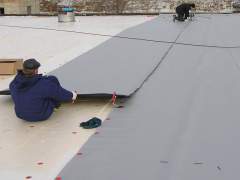 the base of a concrete slab;
the base of a concrete slab;- steam insulation film to protect the insulation from wet fumes coming from the premises;
- heat-insulating material (rock mineral wool in plates and extruded polystyrene are the most commonly used);
- the screed layer (1-3 inches);
- rolled roofing material (2-5 layers).
Technology of laying the roll roofing on a pitched roof
- steam insulation film for an attic or a loft;
- the insulation material between the rafters;
- super-diffuse waterproofing membrane;
- solid sheathing in the form of sheets or waterproof plywood;
- rolled roofing material;
- all the layers of the web material must be laid offset to the joints, so that overlaps do not coincide.
Stages of roll roofing installation:
- Installation of sewers.
- Creating of gravity layer.
- Installation of shower protectors.
- Laying vapor barrier material.
- Laying insulation material.
- Laying of reinforcing mesh.
- Laying cement-sand screed.
- Laying roofing around the water intake funnels and aerators.
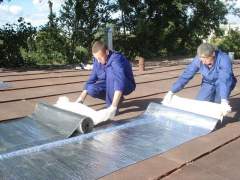 Installation of roofing on the parapets and other vertical and complex elements.
Installation of roofing on the parapets and other vertical and complex elements.- Priming.
- Weld roll material – 1 layer.
- The weld material at the junction.
- Weld roll material – 2 layers.
- Mounting a pressure bar.
- Installation of the apron on the vertical elements, galvanizing.
- Installation of the parapet of the galvanizing.
Preparation of the base
The concrete base must first be cleared of debris, dust and dirt. If the surface is the old coating, it must be removed. All the chips, cracks, potholes are sealed with repair composition. All the further work should start after the repair mortar is completely dried. During this time it’s reasonable to perform the installation of the shower protectors and sewers.
Laying vapor barrier materials
They must be laid with an overlap of 4-6 inches. All the joints are glued with a construction tape. Vapor plant material on all vertical elements have to be to such a height that they should end up above the future location of the insulation material.
Laying insulation materials
For the thermal insulation of flat roofs mineral wool and extruded polystyrene plates are used. The insulation material is laid in two layers to cover the possible “cold bridges”. By the way, the joints between the insulation boards must be placed alternate. Insulating panels can be glued to the base or can be fixed by means of special anchors.
How to apply roll roofing
 Laying begins at the lowest point.
Laying begins at the lowest point.- The roll is unwound and laid on the site of the future installation.
- Before you start to fix it you must check its integrity.
- Fix edge fabric roll. For this heat up the gas burner and push it to the edge of the site where it will be fixed.
- The canvas is rolled up into a roll back to the point of attachment.
- A gas burner is held so that it warms up the ground surface and the lower surface of the material.
- Walking on just laid material is undesirable.
- Gently remove any air bubbles.
- After gluing it’s important to check the edges of the mounting material. If the edge is fixed incorrectly, you need to pull ti out with a spatula and use a gas heater again, pressing it down to the ground.
- The edges of the roll material must be rolled with the utmost care. Movement of the roller must be at a certain angle, starting from the middle and moving to the edges.
- Fabrics are stuck overlapped.
- To lay the rolled material on the parapets, cut a piece of the desired length, then mechanically attach it to the top edge of the parapet, then glued to the base fabric fusing.
- For laying the material in the corners – internal and external – it must be cut as a larger sheet and then to be stuck overlapped.
- For laying the material around the reception funnels of the drainage system it must be glued so that the squares of about 2х2 feet appear around.
- The next layers of the material should be laid exactly in the same sequence. Do not forget about the places of contiguity to vertical objects, parapets, funnels.
We hope this article helped you to answer the question how to lay roll roofing on flat and pitched roofs with your own hands.
